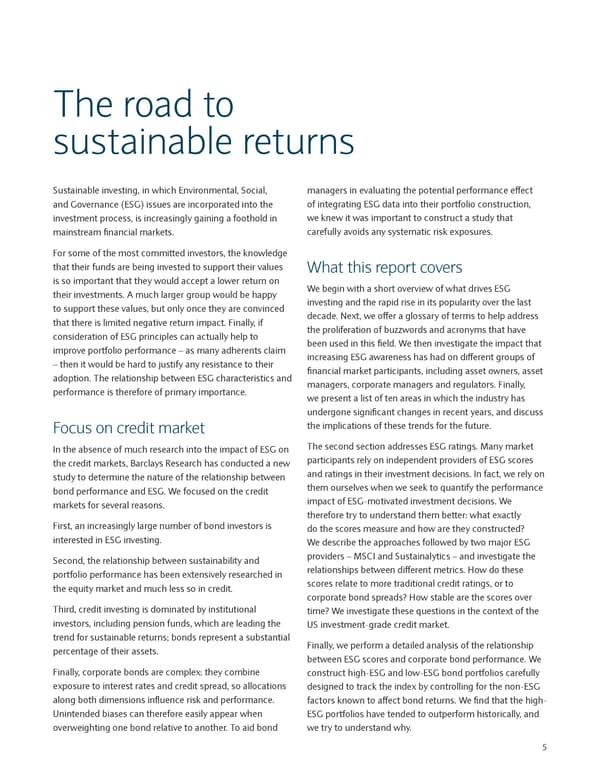The road to sustainable returns Sustainable investing, in which Environmental, Social, managers in evaluating the potential performance effect and Governance (ESG) issues are incorporated into the of integrating ESG data into their portfolio construction, investment process, is increasingly gaining a foothold in we knew it was important to construct a study that mainstream financial markets. carefully avoids any systematic risk exposures. For some of the most committed investors, the knowledge that their funds are being invested to support their values What this report covers is so important that they would accept a lower return on We begin with a short overview of what drives ESG their investments. A much larger group would be happy investing and the rapid rise in its popularity over the last to support these values, but only once they are convinced decade. Next, we offer a glossary of terms to help address that there is limited negative return impact. Finally, if the proliferation of buzzwords and acronyms that have consideration of ESG principles can actually help to been used in this field. We then investigate the impact that improve portfolio performance – as many adherents claim increasing ESG awareness has had on different groups of – then it would be hard to justify any resistance to their financial market participants, including asset owners, asset adoption. The relationship between ESG characteristics and managers, corporate managers and regulators. Finally, performance is therefore of primary importance. we present a list of ten areas in which the industry has undergone significant changes in recent years, and discuss Focus on credit market the implications of these trends for the future. In the absence of much research into the impact of ESG on The second section addresses ESG ratings. Many market the credit markets, Barclays Research has conducted a new participants rely on independent providers of ESG scores study to determine the nature of the relationship between and ratings in their investment decisions. In fact, we rely on bond performance and ESG. We focused on the credit them ourselves when we seek to quantify the performance markets for several reasons. impact of ESG-motivated investment decisions. We therefore try to understand them better: what exactly First, an increasingly large number of bond investors is do the scores measure and how are they constructed? interested in ESG investing. We describe the approaches followed by two major ESG Second, the relationship between sustainability and providers – MSCI and Sustainalytics – and investigate the portfolio performance has been extensively researched in relationships between different metrics. How do these the equity market and much less so in credit. scores relate to more traditional credit ratings, or to corporate bond spreads? How stable are the scores over Third, credit investing is dominated by institutional time? We investigate these questions in the context of the investors, including pension funds, which are leading the US investment-grade credit market. trend for sustainable returns; bonds represent a substantial Finally, we perform a detailed analysis of the relationship percentage of their assets. between ESG scores and corporate bond performance. We Finally, corporate bonds are complex: they combine construct high-ESG and low-ESG bond portfolios carefully exposure to interest rates and credit spread, so allocations designed to track the index by controlling for the non-ESG along both dimensions influence risk and performance. factors known to affect bond returns. We find that the high- Unintended biases can therefore easily appear when ESG portfolios have tended to outperform historically, and overweighting one bond relative to another. To aid bond we try to understand why. 5
 Sustainable Investing and Bond Returns Page 4 Page 6
Sustainable Investing and Bond Returns Page 4 Page 6